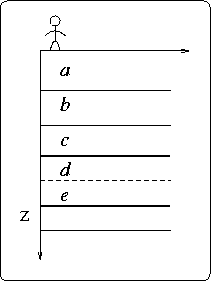




Next: INVERSE LINEAR INTERPOLATION
Up: NULL SPACE AND INTERVAL
Previous: Lateral variations
Sometimes we seek a velocity model that increases smoothly
with depth through our scattered
measurements of good-quality RMS velocities.
Other times, we seek a blocky model.
(Where seismic data is poor,
a well log could tell us whether to choose smooth or blocky.)
Here we see an estimation method that can choose the blocky alternative,
or some combination of smooth and blocky.
Consider the five layer model in Figure ![[*]](http://sepwww.stanford.edu/latex2html/cross_ref_motif.gif) .
Each layer has unit traveltime thickness
(so integration is simply summation).
Let the squared interval velocities be (a,b,c,d,e)
with strong reliable reflections at the base of layer c and layer e,
and weak, incoherent, ``bad'' reflections at bases of (a,b,d).
Thus we measure Vc2 the RMS velocity squared of the top three layers
and Ve2 that for all five layers.
Since we have no reflection from at the base of the fourth layer,
the velocity in the fourth layer is not measured but a matter for choice.
In a smooth linear fit we would want d=(c+e)/2.
In a blocky fit we would want d=e.
.
Each layer has unit traveltime thickness
(so integration is simply summation).
Let the squared interval velocities be (a,b,c,d,e)
with strong reliable reflections at the base of layer c and layer e,
and weak, incoherent, ``bad'' reflections at bases of (a,b,d).
Thus we measure Vc2 the RMS velocity squared of the top three layers
and Ve2 that for all five layers.
Since we have no reflection from at the base of the fourth layer,
the velocity in the fourth layer is not measured but a matter for choice.
In a smooth linear fit we would want d=(c+e)/2.
In a blocky fit we would want d=e.
rosales
Figure 4
A layered earth model.
The layer interfaces cause reflections.
Each layer has a constant velocity in its interior.
|
|  |

Our screen for good reflections looks like (0,0,1,0,1)
and our screen for bad ones looks like the complement (1,1,0,1,0).
We put these screens on the diagonals of diagonal matrices
 and
and  .Our fitting goals are:
.Our fitting goals are:
|  |
(20) |
| (21) |
| (22) |
| (23) |
| (24) |
| (25) |
| (26) |
For the blocky solution, we do not want the fitting goal (25).
Further explanations await completion of examples.





Next: INVERSE LINEAR INTERPOLATION
Up: NULL SPACE AND INTERVAL
Previous: Lateral variations
Stanford Exploration Project
4/27/2004
![[*]](http://sepwww.stanford.edu/latex2html/cross_ref_motif.gif) .
Each layer has unit traveltime thickness
(so integration is simply summation).
Let the squared interval velocities be (a,b,c,d,e)
with strong reliable reflections at the base of layer c and layer e,
and weak, incoherent, ``bad'' reflections at bases of (a,b,d).
Thus we measure Vc2 the RMS velocity squared of the top three layers
and Ve2 that for all five layers.
Since we have no reflection from at the base of the fourth layer,
the velocity in the fourth layer is not measured but a matter for choice.
In a smooth linear fit we would want d=(c+e)/2.
In a blocky fit we would want d=e.
.
Each layer has unit traveltime thickness
(so integration is simply summation).
Let the squared interval velocities be (a,b,c,d,e)
with strong reliable reflections at the base of layer c and layer e,
and weak, incoherent, ``bad'' reflections at bases of (a,b,d).
Thus we measure Vc2 the RMS velocity squared of the top three layers
and Ve2 that for all five layers.
Since we have no reflection from at the base of the fourth layer,
the velocity in the fourth layer is not measured but a matter for choice.
In a smooth linear fit we would want d=(c+e)/2.
In a blocky fit we would want d=e.

